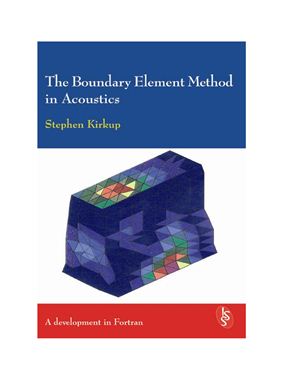The Boundary Element Method in Acoustics.
Author : Stephen Kirkup.
ISBN : 0953403106.
Pages : 158.
Publisher : Integrated Sound Software.
Publication Date : October 1998, revised in 2007.
From the Preface:
The boundary element method (BEM) is a powerful computational technique, providing numerical solutions to a range of scientific and engineering problems. To the user, the main characteristic of the method is that only a mesh of the boundary of the domain is required. Hence, at the very least, the method is easier to apply than the more traditional finite element method.
The subject of this text is the development of boundary element methods for the solution of problems in linear acoustics. Three classes of problem are considered: Chapter 4 - interior acoustic problems, Chapter 5 - exterior acoustic problems and Chapter 6 - the modal analysis of an enclosed fluid. Each class of problem is considered in three domain settings: two-dimensions, three-dimensions and axisymmetry.
In this text the boundary element methods for the solution of acoustic or Helmholtz problems are developed in a bottom-up way. Chapter 2 is on the preparation of the boundary and surface meshes. Chapter 3 considers the techniques employed in reducing the integral equation to discrete form. The solution of the acoustic problems are considered in Chapters 4 to 6 .
Intended Audience:
A library of Fortran 77 routines have been developed alongside this text. Each acoustic problem considered in this text can be solved through simply calling one Fortran routine. The user must simply set up the parameter list for the subroutine in order to obtain the numerical solution by the BEM and to interpret the results. The source code is made available so that the methods employed are entirely transparent. Although the mathematical development of the methods is given in this text, the software can be used without any knowledge of these details. Users of the software will need to have a working knowledge of Fortran.
Author : Stephen Kirkup.
ISBN : 0953403106.
Pages : 158.
Publisher : Integrated Sound Software.
Publication Date : October 1998, revised in 2007.
From the Preface:
The boundary element method (BEM) is a powerful computational technique, providing numerical solutions to a range of scientific and engineering problems. To the user, the main characteristic of the method is that only a mesh of the boundary of the domain is required. Hence, at the very least, the method is easier to apply than the more traditional finite element method.
The subject of this text is the development of boundary element methods for the solution of problems in linear acoustics. Three classes of problem are considered: Chapter 4 - interior acoustic problems, Chapter 5 - exterior acoustic problems and Chapter 6 - the modal analysis of an enclosed fluid. Each class of problem is considered in three domain settings: two-dimensions, three-dimensions and axisymmetry.
In this text the boundary element methods for the solution of acoustic or Helmholtz problems are developed in a bottom-up way. Chapter 2 is on the preparation of the boundary and surface meshes. Chapter 3 considers the techniques employed in reducing the integral equation to discrete form. The solution of the acoustic problems are considered in Chapters 4 to 6 .
Intended Audience:
A library of Fortran 77 routines have been developed alongside this text. Each acoustic problem considered in this text can be solved through simply calling one Fortran routine. The user must simply set up the parameter list for the subroutine in order to obtain the numerical solution by the BEM and to interpret the results. The source code is made available so that the methods employed are entirely transparent. Although the mathematical development of the methods is given in this text, the software can be used without any knowledge of these details. Users of the software will need to have a working knowledge of Fortran.

